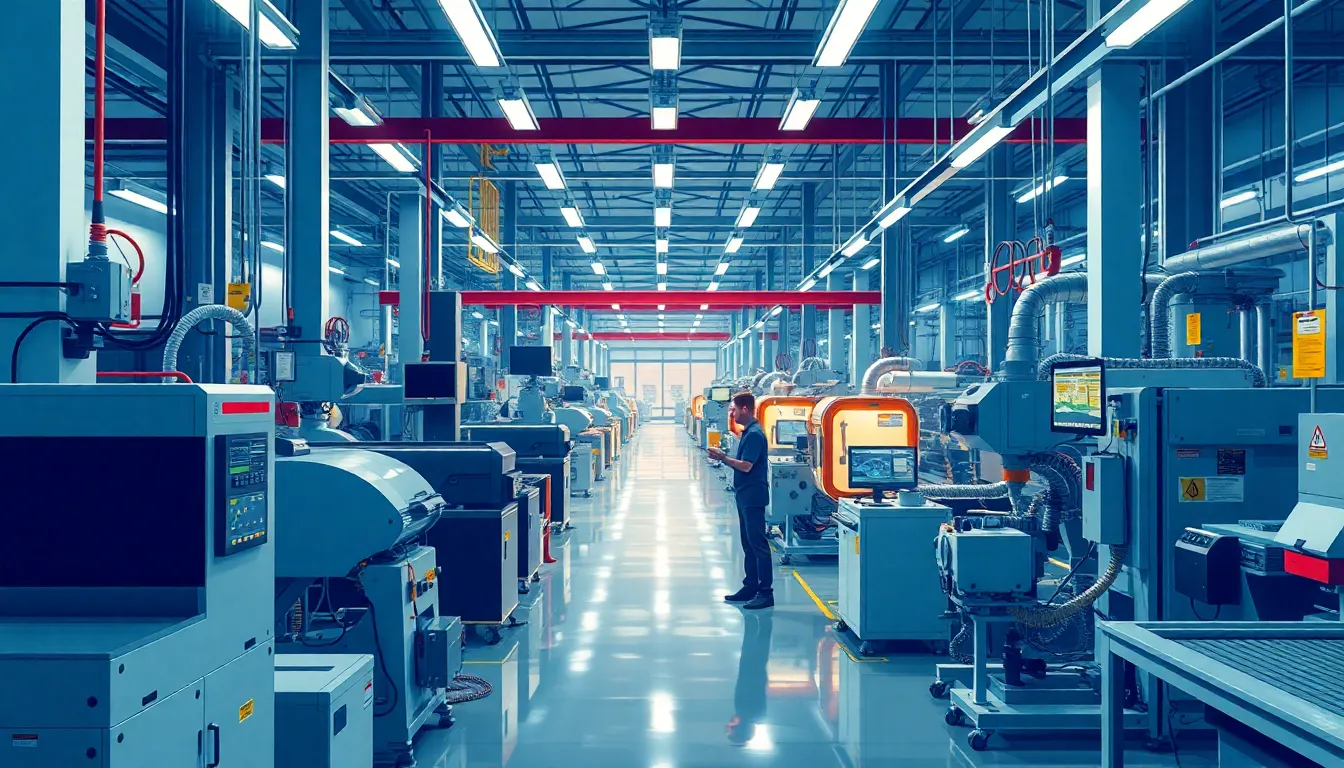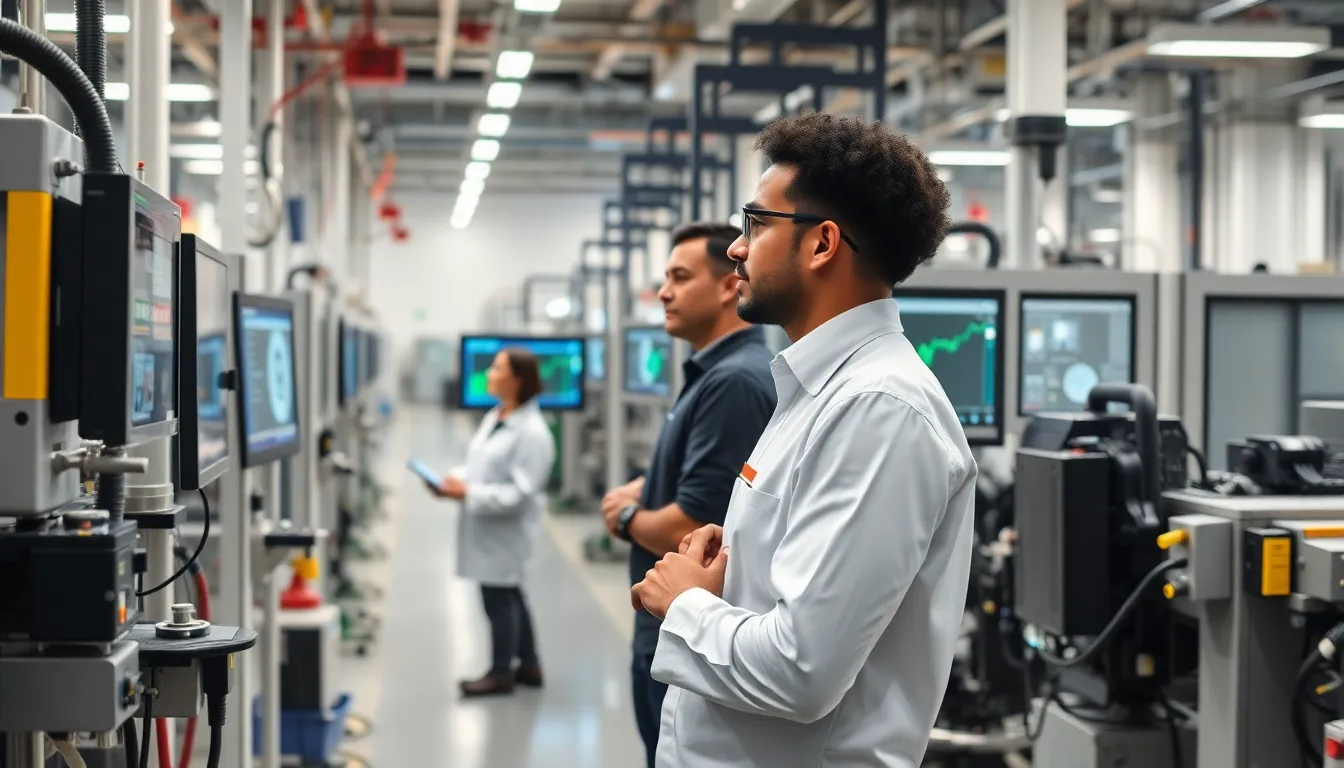In a world where toasters can talk and fridges can order groceries, the Internet of Things (IoT) has transformed everyday life into a sci-fi movie. But wait—there’s a more serious contender in the ring: the Industrial Internet of Things (IIoT). While IoT connects your smart home devices, IIoT is busy revolutionizing factories and supply chains, making them smarter and more efficient than ever.
Imagine a factory where machines chat with each other about their feelings—well, sort of. IIoT takes automation to the next level, optimizing processes and reducing downtime. So, what’s the difference between these two tech titans? Buckle up as we dive into the quirky yet fascinating world of IoT and IIoT, exploring how they shape our lives and industries in ways that might just make you chuckle.
Table of Contents
ToggleOverview of IoT and IIoT
The Internet of Things (IoT) connects devices in homes and everyday environments, enabling seamless interaction. Smart appliances, wearables, and connected systems exemplify IoT applications. Data collected from these devices offers insights into user behavior and preferences, enhancing the overall experience.
In contrast, the Industrial Internet of Things (IIoT) applies similar technology within industrial settings, including manufacturing plants and supply chains. IIoT emphasizes efficiency and reliability, transforming operations by integrating sensors, machines, and analytic tools. Real-time data monitoring leads to improved decision-making and proactive maintenance, reducing downtime significantly.
Both IoT and IIoT rely on sensors to gather data. Sensors embedded in home devices track temperature or energy usage. Similar sensors in industrial machinery monitor performance metrics and detect anomalies.
The scalability of IoT varies versus IIoT. IoT often involves thousands of consumer devices, while IIoT typically integrates fewer, but more complex, industrial systems. This complexity allows IIoT solutions to optimize extensive networks while maintaining control over intricate processes.
Security concerns also differ between the two. IoT devices often face personal data breaches, while IIoT systems prioritize protecting intellectual property and operational integrity. Both domains require robust security frameworks to safeguard sensitive information.
Adoption rates reflect distinct trends. IoT has gained significant momentum in consumer markets, driven by demand for smart home technologies. Conversely, IIoT is progressively adopted by industries seeking to enhance automation and improve operational efficiency. Each sector addresses unique challenges while leveraging connected technologies to drive innovation.
Key Differences Between IoT and IIoT

IoT and IIoT play distinct roles in technology. Understanding their differences clarifies their applications in various environments.
Definition of IoT
The Internet of Things (IoT) refers to a network of interconnected devices that communicate and share data over the internet. These devices typically include consumer technology such as smart home appliances, wearables, and smart speakers. In everyday life, IoT enhances convenience and efficiency by automating tasks and providing real-time information to users. For example, smart thermostats learn user preferences and adjust temperatures automatically. IoT focuses on improving user experiences while harnessing data-driven insights for personalization.
Definition of IIoT
The Industrial Internet of Things (IIoT) encompasses a specific adaptation of IoT technology for industrial and manufacturing applications. IIoT involves sensors and devices that monitor and analyze machinery performance, production processes, and supply chain logistics. Essential for enhancing productivity, IIoT technologies optimize operations through real-time data analysis and predictive maintenance. For instance, predictive analytics can minimize downtime by identifying potential equipment failures before they occur. IIoT prioritizes operational efficiency, safety, and reliability in industrial settings, ultimately driving innovation and competitive advantage in various sectors.
Applications of IoT
IoT technology finds application in various fields, enhancing convenience and efficiency in everyday activities and urban infrastructure.
Consumer Applications
Smart devices form the backbone of consumer applications. These gadgets, including wearables and home appliances, streamline daily tasks and provide connectivity. Users enjoy seamless interactions through features like remote monitoring and automation, which significantly simplifies routine activities. Data collected from devices helps users optimize energy consumption and improve health metrics. Market research indicates that smart home devices are projected to reach a value of $174 billion by 2025, highlighting the rapid adoption of IoT technologies in consumer markets.
Smart Homes and Cities
Smart homes promote energy efficiency and improve security through interconnected systems. Homeowners can manage lighting, heating, and security remotely, enhancing comfort and safety. In smart cities, IoT technology optimizes resources and facilitates communication between infrastructures. Traffic management systems reduce congestion by analyzing real-time data, while smart waste management enhances resource allocation. Research shows that investments in smart city technologies could save cities around $780 billion annually by improving efficiency and reducing operational costs.
Applications of IIoT
IIoT significantly enhances industrial processes with a range of applications. Focusing on efficiency and reliability, it transforms how industries operate.
Industrial Automation
Automation in manufacturing benefits greatly from IIoT technology. Sensors integrated into machinery collect continuous performance data, enabling real-time monitoring. Companies use this data to optimize production lines, thereby reducing delays and increasing output. Predictive maintenance emerges as a key benefit, allowing manufacturers to perform timely repairs before equipment failures occur. Implementation of smart sensors leads to enhanced safety standards by minimizing human error and maximizing operational efficiency.
Supply Chain Management
Supply chain management sees improvement through IIoT as well. Sensors embedded in products track their location and condition throughout the logistics process. This visibility allows companies to respond swiftly to disruptions and enhances inventory management. Real-time data analysis enables better forecasting of stock levels, preventing shortages or overstock situations. Greater transparency results in improved collaboration among supply chain partners, creating more resilient and efficient operations.
Benefits of IoT
IoT introduces numerous benefits across various sectors. Enhanced efficiency stands out as a critical advantage, as devices automate routine tasks. Improved data collection emerges as another key benefit, enabling users to gather insights into user behavior and operational processes. Cost savings also accompany IoT adoption; manufacturers reduce energy expenditures through optimized resource use.
Increased convenience contributes significantly to user satisfaction. Smart homes offer seamless control of appliances, improving daily living. Enhanced safety features further elevate user trust, as smart cameras and alarms provide peace of mind. Real-time monitoring plays a crucial role as well; users can track and manage devices remotely, allowing for immediate responses to issues.
Scalability is another notable feature, allowing IoT systems to expand easily. Businesses can add more devices without extensive infrastructure changes. Enhanced collaboration results from interconnected systems, enabling diverse devices to communicate and share data. Improved customer experiences happen as personalized services become more relevant and timely.
Research indicates that investment in IoT technologies fuels economic growth. The smart home devices market is projected to reach $174 billion by 2025, underscoring its trajectory. Additionally, implementing IoT in cities can save up to $780 billion annually through improved efficiencies. As industries harness these benefits, IoT continues redefining how organizations and consumers interact with technology.
Overall, every facet of IoT contributes uniquely to enhancing daily operations and experiences. The emphasis on automation leads to increased productivity across sectors. Enhanced insights from data collection drive better decision-making and resource management.
Benefits of IIoT
IIoT offers numerous benefits that significantly enhance operational efficiency. Enhanced productivity occurs through real-time data analysis, which allows industries to fine-tune processes. Predictive maintenance reduces the likelihood of equipment failure, leading to lower downtime and increased output.
Cost savings emerge from improved resource management during manufacturing. By monitoring equipment and supply chains, businesses can optimize inventory levels and reduce waste. Better decision-making is facilitated through actionable insights derived from comprehensive data analytics.
Safety standards increase with real-time monitoring, allowing for immediate actions to mitigate risks in industrial environments. Enhanced collaboration between supply chain partners occurs by sharing critical information regarding equipment and product conditions.
Scalability remains an important feature, as IIoT systems grow alongside business needs. Flexibility is built into the architecture of IIoT solutions, accommodating varying sizes of operations and processes.
Integration of advanced technologies, such as artificial intelligence and machine learning, generates further innovation within IIoT systems. These technologies enhance predictive analytics and automate operational tasks, leading to smarter factories.
Furthermore, compliance with regulations improves through consistent monitoring and reporting capabilities. IIoT contributes to maintaining high standards by tracking essential metrics relevant to industry regulations.
Research indicates that industries implementing IIoT gain a competitive edge, as these technologies drive overall business growth. With industrial sectors progressively adopting IIoT solutions, the transformation toward more efficient operations continues to unfold.
The distinctions between IoT and IIoT highlight their respective roles in transforming daily life and industrial operations. While IoT enhances consumer convenience with smart devices IIoT pushes the boundaries of efficiency in manufacturing and supply chains. Each technology offers unique benefits tailored to its environment.
As industries increasingly adopt IIoT solutions the focus on automation and real-time data will continue to drive innovation. Meanwhile IoT will remain pivotal in shaping smart homes and cities fostering connectivity and convenience for consumers. Understanding these differences is crucial for leveraging their potential and maximizing the benefits they bring to society and industry alike.





